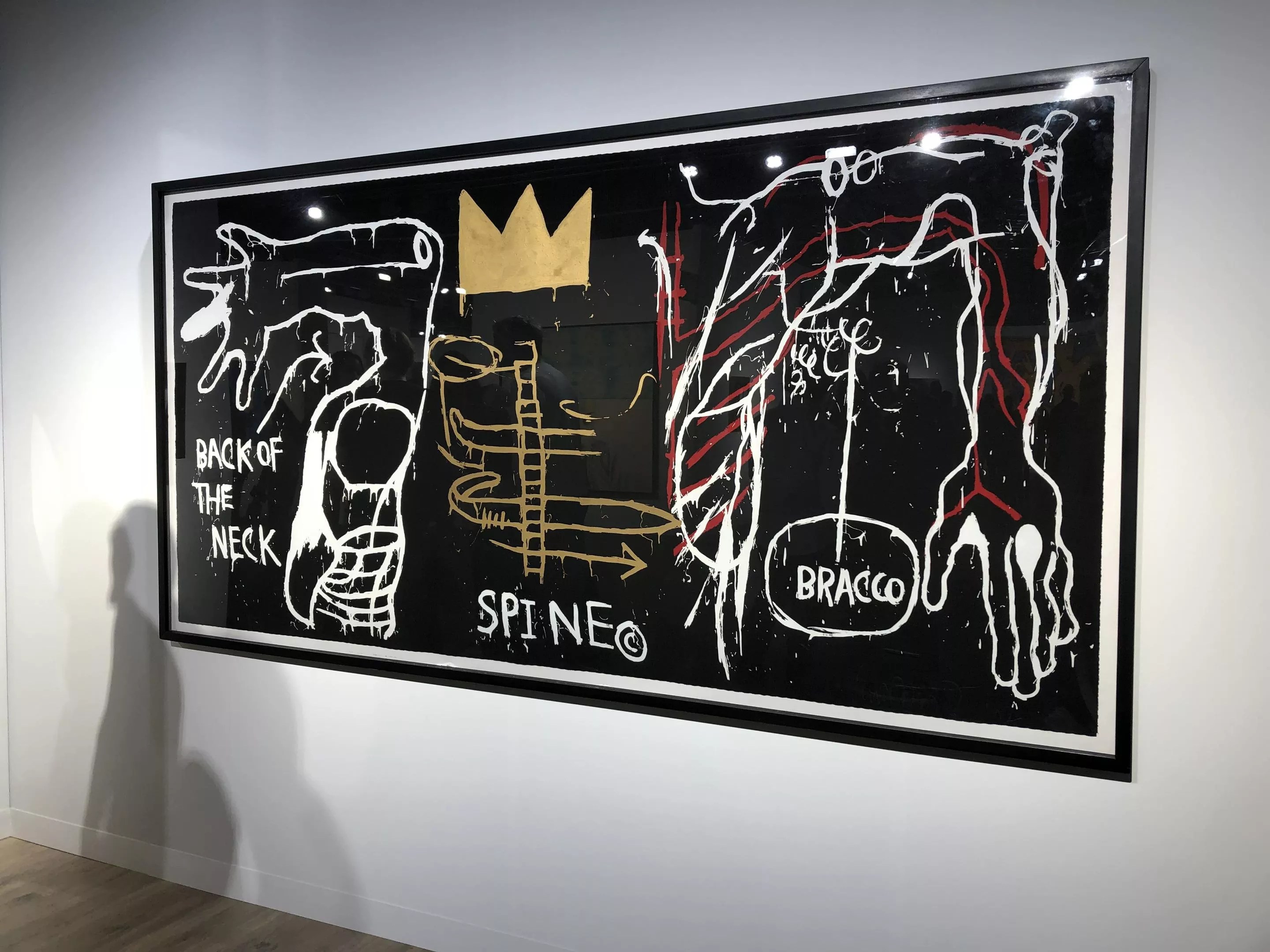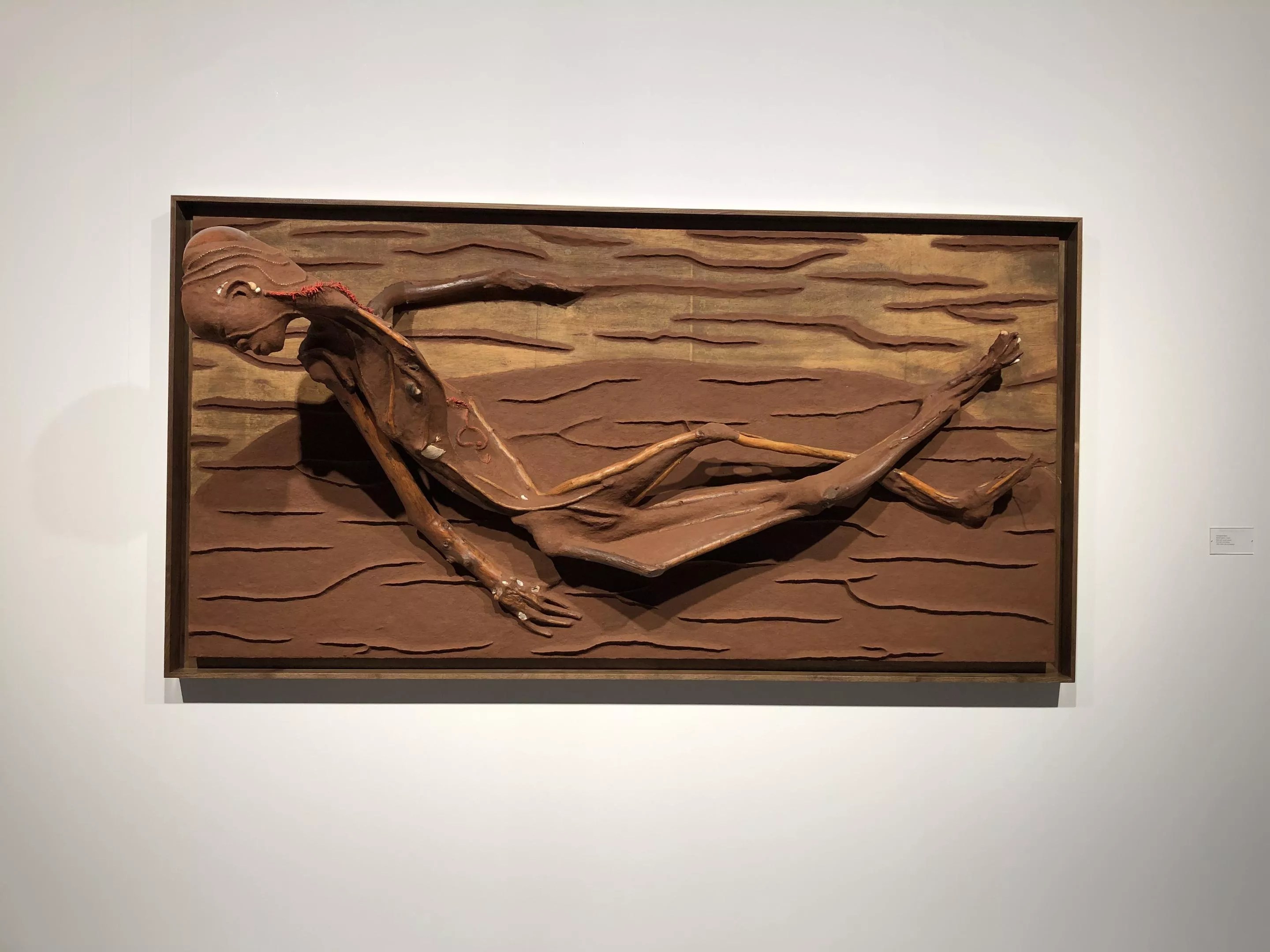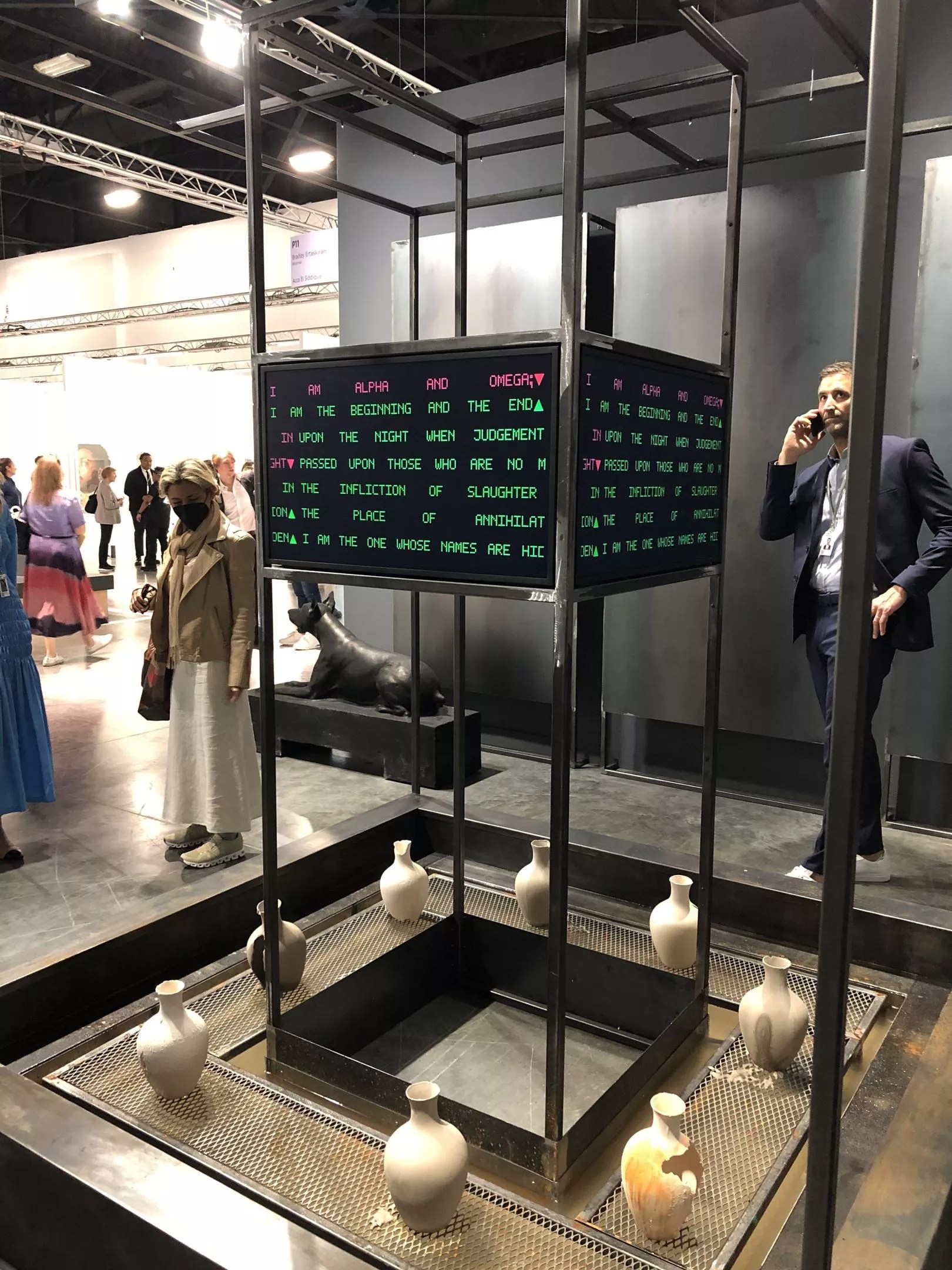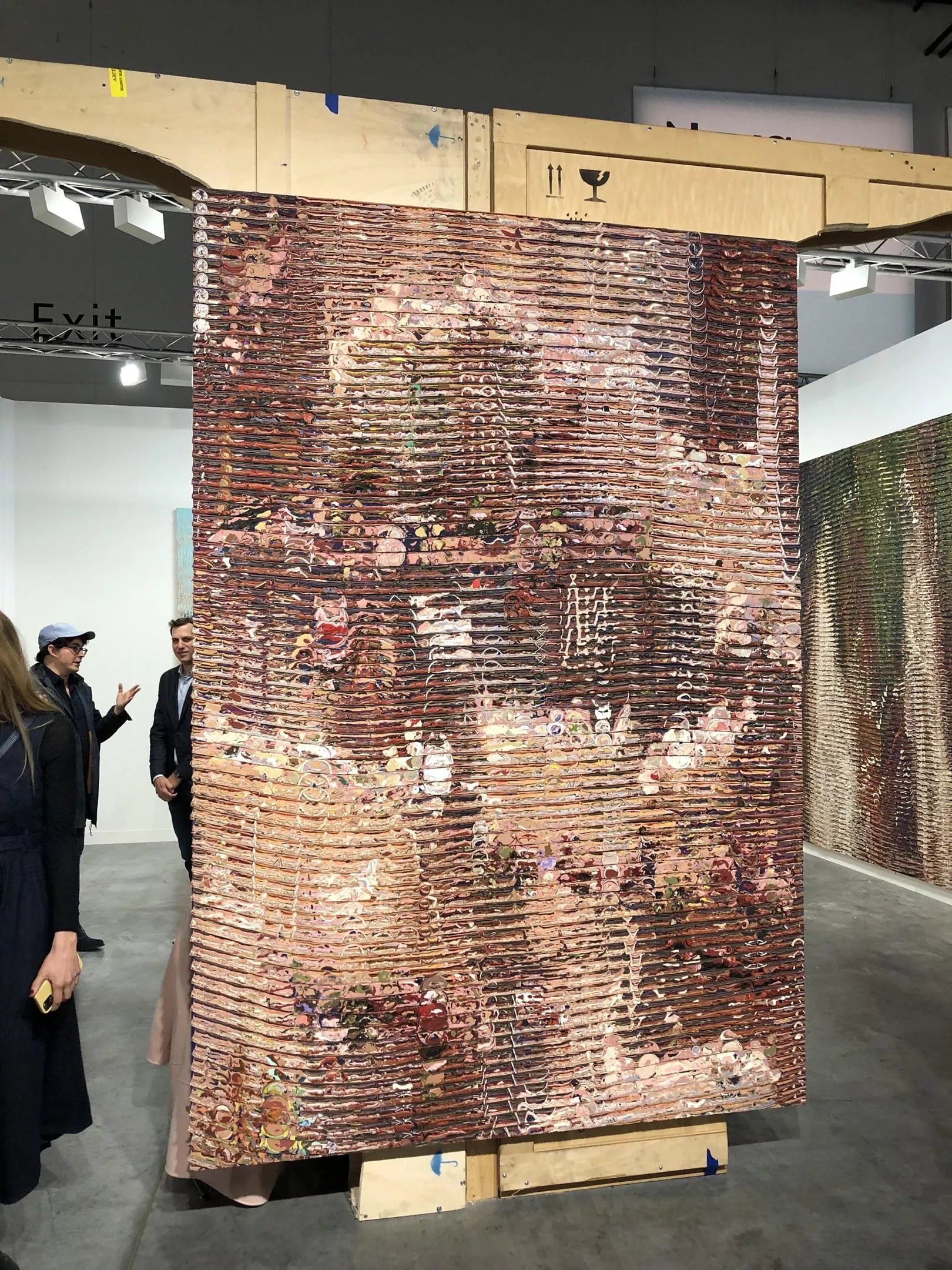
Art Basel photo

Audio By Carbonatix
Maybe it was the overcast sky and chilly temperatures outside, or perhaps the rows and rows of artwork were starting to wear me down, but I couldn’t help but feel something deathly in the air at Art Basel Miami Beach. I’ve been attending Basel for years at this point, mostly as a reviewer for this publication, and the more and more I stalked the booths at the Miami Beach Convention Center, looking for something, anything truly original, the more I kept seeing memento mori: skulls, tomblike installations, grim colors.
Sure, there are rumors that the art market is about to crash, but do the vibes have to be this off?
Everywhere I looked, the art felt particularly foreboding. There were a lot of Francis Bacon paintings in the blue-chip booths, some rather imposing black-and-white paintings by Basquiat (Back of the Neck), and Dubuffet greeted visitors at one entrance. There were lots of mirrors, from a Jenny Holzer wall-size work decrying “politics without principles, wealth without toil” and so on, to one by Alvaro Barrington warning passersby, “Streets is watching.” Anish Kapoor’s concave Yellow to Orange at Mennour gave a different reflection with each change in position, while another mirror nearby from Ryan Gander featured a white robe with a pointy hood hung over the frame. Maybe these artists want their wealthy consumers to do some literal self-reflection.

Jean-Michele Basquiat’s Back of the Neck at Van de Weghe Fine Art
Photo by Douglas Markowitz
No booth better epitomized the gothic sensibilities afoot than blue-chip-art purveyor Gladstone Gallery. Against the somber gray walls inside the booth, Gladstone hung a Keith Haring black ink-on-paper print of stick figures climbing out of a giant skull, as well as three hellacious large-scale, black-and-white photographs by filmmaker Arthur Jafa, exploring “America’s propensity to conflate violence and cultural production,” according to the gallery. In big block letters, a Rikrit Tiravanija newspaper collage declared, “The days of this society are numbered.”
On the outer walls, Kenyan-American artist Wangechi Mutu, famed for her mythological sculptures, hung two works from her Buried Bride series. Each featured a female figure made to look as if it had been mummified, and rather than paint them, the artist sculpted each form out of wood and soil, making them appear as if we’re looking into an alien sarcophagus hung on a wall. It was an incredibly chilling, regal display.

Wangechi Mutu’s Buried Bride I at Gladstone
Photo by Douglas Markowitz
Ancient tombs also inspired Sudanese artist Azza El Siddique’s installation Final Fantasy, staged in Positions by Montreal-based Bradley Ertaskiran Gallery. Flanked by two Anubis-like guardian dog statues, the installation featured a large metal frame structure rigged to drip water into a group of earthen pots, some already eroding from the constant stream of fluid. The work was about entropy, decay, inevitability, and the idea that we all have a single destination, a single place to return to, something emphasized by the four screens in the central pillar displaying teletext readings from sources like Revelations and the Egyptian Book of the Dead. Adding a technological element by way of the screens is a deft touch from the artist, blending the new into the old and presenting a cool, stylishly industrial aesthetic straight out of a Denis Villeneuve movie.

Azza El Siddique’s Final Fantasy at Bradley Etaskiran Gallery
Photo by Douglas Markowitz
This isn’t to say Basel didn’t have its fair share of whimsy this year. Chinese dissident artist Ai Weiwei satirized the growing geopolitical rivalry between the People’s Republic and the United States by reimagining the classic, ten-foot-tall American history painting Washington Crossing the Delaware in Legos. Perhaps it was a nod to China’s status as a global manufacturing hub and America’s dependence on the country for all our consumer goods. And maybe putting old George in there is a reference to the U.S. foreign policy establishment’s increasingly hawkish attitudes toward Beijing, epitomized by the inclusion of Beijing’s National Stadium (AKA the Bird’s Nest), a symbol of China’s emergence as a major player on the world stage. At P.P.O.W., Pepón Osorio’s My Beating Heart (Mi Corazón Latiente) took the form of a piñata in the shape of a human heart, presumably the artist. In a really incredible touch, Osorio built speakers into the work, which played the sound of an actual heartbeat.

Loriel Beltrán created an entryway arch out of discarded art shipping crates at Central Fine.
Photo by Douglas Markowitz
While many past Basels have had an artwork that dwarfs all others in ridiculousness – Mauricio Cattelan’s banana, last year’s billionaire ranking ATM by Mschf – the closest I could find was Fantasy World, an installation by Anthony Akinbola that was, literally, just a prize claw game. An attendant gave players two quarters (or rather, she inserted the coins herself so the visitors could avoid actually touching filthy, dirty money), and they tried to grab a prize with the claw, ranging from luxury watches to stuffed animals – and some people actually won. The concept of the work had to do with “tension between intrinsic and prescribed value,” asking us to question what really matters when we gamble with a game like this: the experience of playing it or the prize we receive. Is it the journey or the destination? I know one thing for sure: I really, really wanted that goddamn Charmander doll, and I didn’t get it. At least the magazines were free.
Locals had a pretty strong showing this year, with five galleries exhibiting at the fair. Fredric Snitzer showed work from the likes of José Bedia, Tomas Esson, Carlos Alfonso, and Troy Simmons, while Spinello Projects mounted a Positions presentation of Esaí Alfredo’s queer-themed figurations, part of a larger city-wide focus on LGBTQ artists. My favorite presentation from a Miami gallery was Loriel Beltrán’s new paintings at Central Fine. The artist expanded on his unique layered painting process by adding colada cups and bits of plastic to the canvas. “Our world is contaminated by microplastics,” he said, “so our paintings should be contaminated as well.” The booth also featured an arched entryway made of the cast-off wooden crates used to ship artworks to fairs like Basel. Such elegant commitment to environmental commentary is what makes Beltrán a consummately Miami artist.

Reginald O’Neal’s The Cellist in the Meridians section of Art Basel Miami Beach
Photo by Douglas Markowitz
Another local artist, Reginald O’Neal, managed to turn the greyscale gloom of the fair into an expression of radical joy. O’Neal’s sculpture The Cellist, presented in the Meridians section for large-scale projects, is a monumental reproduction of his earlier painting, featuring a figurine of a Black cellist cast in shadow, back turned to the audience. O’Neal said the work was a commentary on how Black artists and musicians are often forced to commodify their passions. In the sculpture version, the cellist faces a gray-painted wall, turning away from an audience and keeping his talent and love of music all to himself. If the art world goes away, and we can all get away from the idea that art must be tied to a market, maybe that would be a good thing, wouldn’t it?
Art Basel. Friday, December 8, through Sunday, December 10, at Miami Beach Convention Center, 1901 Convention Center Dr., Miami Beach; artbasel.com. Tickets cost $58 to $3,500.